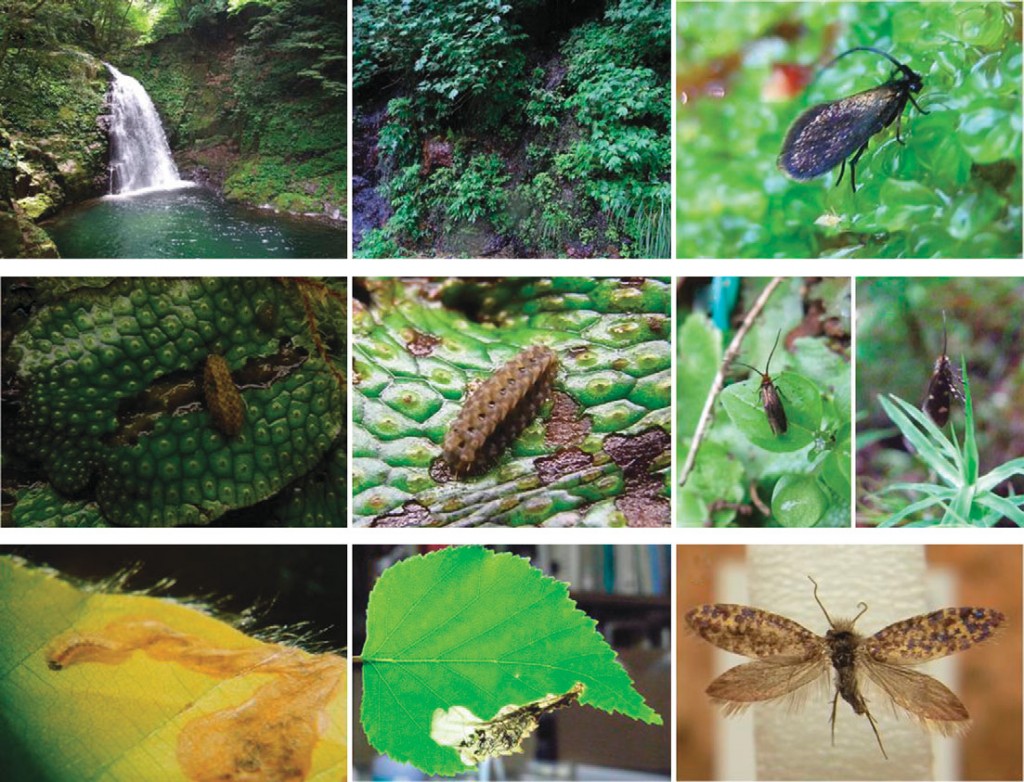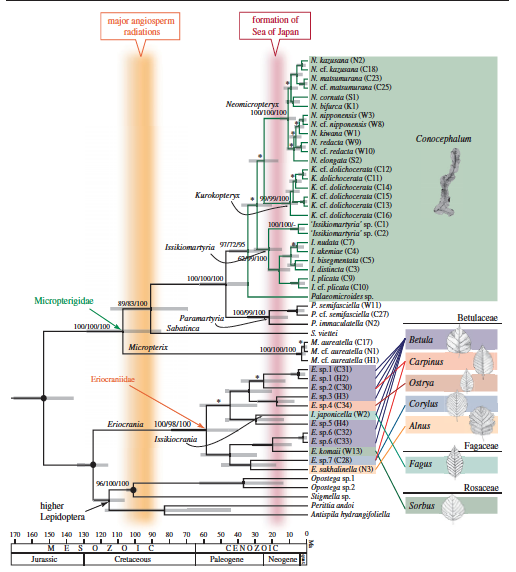![]() Alla är säkerligen bekant med standardmodellen för en mal eller fjäril – ett sugrör-liknande snabel att nå nektar gömda i blommor. Den stora majoriteten av Lepidoptera har diversifierat tillsammans med strålning av angiosperm växter, bli en av de mest mångsidiga och rika order av livet på jorden. This paradigm however does not apply to the Micropterigidae, som representerar inte bara den mest basala stammen av Lepidoptera, men är en av tre familjer som har bibehållit mandibles för slipning pollen eller sporer och förlitar sig på mossor, ruttnande organiskt material eller svampar som larver värd. Prior assumptions as to the diversity of this group were based on the vast age of the lineage (110 miljoner år) och en uppbyggd av gamla släkten. Ett senaste dokument om de japanska arterna of Micropterigidae by Yume Imada and her colleagues at Kyoto University provides evidence to the contrary and applies molecular techniques to test the hypothesis of allopatric speciation without niche shift.
Alla är säkerligen bekant med standardmodellen för en mal eller fjäril – ett sugrör-liknande snabel att nå nektar gömda i blommor. Den stora majoriteten av Lepidoptera har diversifierat tillsammans med strålning av angiosperm växter, bli en av de mest mångsidiga och rika order av livet på jorden. This paradigm however does not apply to the Micropterigidae, som representerar inte bara den mest basala stammen av Lepidoptera, men är en av tre familjer som har bibehållit mandibles för slipning pollen eller sporer och förlitar sig på mossor, ruttnande organiskt material eller svampar som larver värd. Prior assumptions as to the diversity of this group were based on the vast age of the lineage (110 miljoner år) och en uppbyggd av gamla släkten. Ett senaste dokument om de japanska arterna of Micropterigidae by Yume Imada and her colleagues at Kyoto University provides evidence to the contrary and applies molecular techniques to test the hypothesis of allopatric speciation without niche shift.
Författarna reste till 46 localities across the Japanese archipelago and collected all 16 kända endemiska arter, några nya arter, och förmodligen ett nytt släkte. Finding these moths in the wild is not all that difficult if you know how to find the habitat and how not to fall off slippery rocks; men när du hittar den plats de nattfjärilar kan vara riklig. Micropterigidae are unsurprisingly associated with their bryophytes, som förekommer i fuktiga miljöer längs bäckar och floder. The very nature of a minute and slow moving animal in isolated pockets lends itself to allopatric speciation. Many microlepidoptera barely fly off of their host plant and even when they do they are not known for long distance dispersal. While the majority of genera and species are completely isolated across Japan there are a few instances where the genus Paramartyria occurs within populations of Issikiomartyria. While it is unknown precisely how these species might partition their host resources it is very likely to be a temporal difference in life-cycles. Here in California there is a vastly confusing complex of Apodemia butterflies that comprise a handful of species and (naturligtvis) underart som partitionerade på samma planta genom våren och hösten avel säsonger.
Imponerande, every micropterigid collected as larvae were found only on the Conocephalum conicum arter av levermossa, trots att det är upp till fjorton andra mossor arter finns i samma livsmiljö. It had been long understood that the Asian Micropterigidae fed on liverworts, men omfattningen av deras värdspecificitet aldrig hade kvantifierats. Feeding behavior appears to be the same across all of the surveyed species, med larver betar längs den övre delen av mossor konsumerar de övre vävnadsskikten.
Fylogenetisk analys av COI, 18S och EF-1α gener genererade mycket kongruenta träd med flera analysmetoder. It appears that the endemic Japanese genera and the Conocephalum utfodring strategi utgör en bra stöd monofyletisk klad (i grönt). I korthet, the radiation of the host-specific Micropterigidae coincide with the separation, lyfta, och isolering av den japanska landmassa ungefär 20 million years ago. It could not have been difficult to propose the hypothesis that the diversity of the Japanese Micropterigidae could only be as old as the island itself; and it’s also an accepted fact today that allopatric speciation happens more commonly than once thought. But quantifying these theories and explaining how and why this happens is exactly what science is about.
Litteratur som citeras
Imada Y, Kawakita En, & Kato M (2011). Allopatric distribution och diversifiering utan nisch förskjutning i mossor, utfodring basala mal härstamning (Lepidoptera: Micropterigidae). Proceedings. Biologiska vetenskaper / Royal Society, 278 (1721), 3026-33 PMID: 21367790
Scoble, MJ. (1992). Lepidoptera: Form, function, and diversity. Oxford Univ. Press.



Intressant. Note that the single species [to my knowledge] of Micropterygidae in the western US, Epimartynia pardella, also feeds on Conocephalum conicum. [unpublished obs.] Don’t know if it nests within the Japanese species, but I’d question that the japanese species had to differentiate within the confines of the present archipelago…